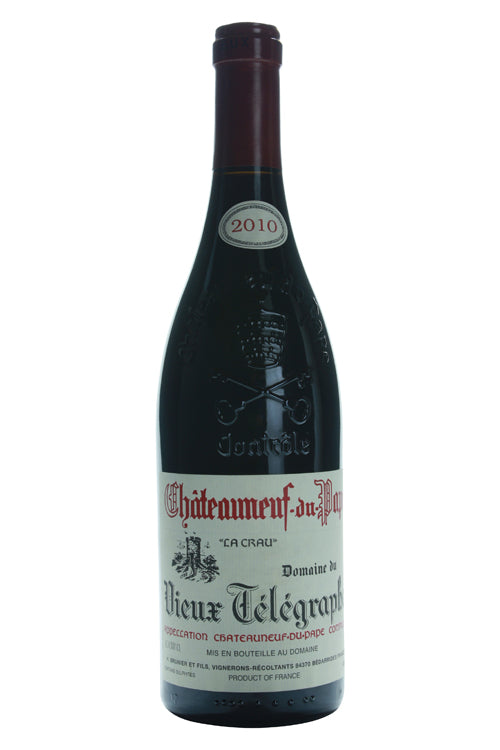1
/
of
1
Vieux Telegraphe Châteauneuf-du-Pape La Crau - 2010 (750ml)
Vieux Telegraphe Châteauneuf-du-Pape La Crau - 2010 (750ml)
Regular price
$89.99
Sale price
$89.99
Regular price
$109.99
Unit price
/
per
Performing considerably better than it did prior to bottling, the 2010 Vieux Telegraphe Chateauneuf du Pape is one of the all-time great Vieux Telegraphes I have tasted in the last 3+ decades. I believe it is even superior to the 2007, which I had several weeks ago. The 2010 boasts a dense purple color along with a sumptuous bouquet of spring flowers, boysenberries, black cherries, black currants, nori (the sushi seaweed wrapper), black olives, licorice and pepper. This full-bodied, meaty, thick, juicy effort possesses a boatload of tannin, but it also has incredible concentration. More massive than I remember from last year, it has put on considerable weight and intensity. Forget it for 3-4 years, and drink it over the following 25-30 years. Kudos to Daniel and Frederic Brunier!
Robert Parker - 97 points
Robert Parker - 97 points
Share :

- varietal
- Region
- Sub - Region
- Type
- Reviews
Product Review
Performing considerably better than it did prior to bottling, the 2010 Vieux Telegraphe Chateauneuf du Pape is one of the all-time great Vieux Telegraphes I have tasted in the last 3+ decades. I believe it is even superior to the 2007, which I had several weeks ago. The 2010 boasts a dense purple color along with a sumptuous bouquet of spring flowers, boysenberries, black cherries, black currants, nori (the sushi seaweed wrapper), black olives, licorice and pepper. This full-bodied, meaty, thick, juicy effort possesses a boatload of tannin, but it also has incredible concentration. More massive than I remember from last year, it has put on considerable weight and intensity. Forget it for 3-4 years, and drink it over the following 25-30 years. Kudos to Daniel and Frederic Brunier!
Product Score
97
Grenache has claims to have originated in Spain and Sardinia where it is known as Garnacha and Cannonau respectively. No matter where it originated this sun-loving grape has spread with great popularity across the world. The grape’s compatibility with regions that offer long sunny summers ensures a high build up of sugars and conversely low acidity. This and its soft tannin make it a great blending grape with firmer, more structured varieties such as Syrah and Mourvedre to form the trio blend often called GSM. Grenache is frequently grown alongside its blending partners in the esteemed regions of Chateauneuf-du-Pape in the Rhone valley and accross South Australia. Unlike a lot of other varieties Grenache needs relatively little attention and is quite happy to be left on poor, unirrigated soils. Because of this hearty nature, pockets of old, neglected, but still productive vines have been found around the world. With enough pruning, these old vines yield small amounts of intense fruit with spectacular results in varietal wines. Depending on where it is grown and how it is handled Grenache can vary from earthy and peppery to jammy red and black fruit with sweet spice qualities. It is also the key constituent (at least 50%) in the wines of Banyuls, one of France’s finest Vins Doux Naturels appellations.
The Rhone is one of France’s most important wine regions. Divided into two separate zones, the north is probably the most prestigious. It is home to the appellations of Condrieu, Côte Rôtie, St. Joseph, Hermitage, and Crozes-Hermitage. Syrah is king with the exception of the Condrieu (100% Viognier) and Hermitage, which also makes big whites from Marsanne and Roussanne. The South is a much larger region where most Cotes du Rhone and Cotes du Rhone Village come from. In the villages of Châteauneuf-du-Pape, Gigondas, Vacqueyras, and Rasteau, Syrah is blended in varying proportions with Grenache, Mourvedre, Cinsaut, and a host of obscure varieties such as Muscardin, Vaccarese, Terret and Counoise, to produce full-bodied reds brimming with energy.
Châteauneuf-du-Pape is the most famous village in the southern Rhone. It is here that Grenache, the primary varietal, is arguably at its very best. Syrah, Mourvedre, and Cinsaut are also normally included however the proportions can vary significantly from producer to producer. In some cases (Château Beaucastel), all thirteen permitted varieties are included. They are often very age-worthy wines with incredible depth and concentration, and which develop complex secondary aromas including dried fruit, spice and earth.
Red wine is wine made from dark-coloured grape varieties. The color of red differs based on the grapes variety or varieties used.Interestingly, black grapes yield a juice that is greenish-white. The actual red color comes from anthocyan pigments (also called anthocyanins) from the skin of the grape (exceptions are the relatively uncommon teinturier varieties, which produce a red colored juice). Most of the production centers around the extraction of color and flavor from the grape skin.


